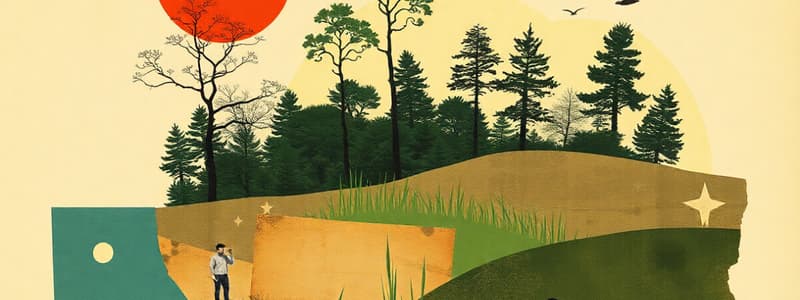Podcast
Questions and Answers
Which process involves plants converting air into sugar using sunlight and water?
Which process involves plants converting air into sugar using sunlight and water?
Combustion of fossil fuels adds oxygen to the atmosphere.
Combustion of fossil fuels adds oxygen to the atmosphere.
False
Name one negative impact on the environment mentioned in the content.
Name one negative impact on the environment mentioned in the content.
Pollution, Deforestation, Overfishing, or Using too many resources
The process by which fungi and bacteria break down dead organisms is called ______.
The process by which fungi and bacteria break down dead organisms is called ______.
Signup and view all the answers
Match the following environmental concepts with their descriptions:
Match the following environmental concepts with their descriptions:
Signup and view all the answers
What initiates primary succession?
What initiates primary succession?
Signup and view all the answers
Pioneer species are the first organisms to inhabit an area in secondary succession.
Pioneer species are the first organisms to inhabit an area in secondary succession.
Signup and view all the answers
What is ecological balance?
What is ecological balance?
Signup and view all the answers
In primary succession, __________ species help break down rock to form soil.
In primary succession, __________ species help break down rock to form soil.
Signup and view all the answers
Match the ecosystems to their characteristic stages of recovery:
Match the ecosystems to their characteristic stages of recovery:
Signup and view all the answers
During which stage of secondary succession do animals typically return?
During which stage of secondary succession do animals typically return?
Signup and view all the answers
The water cycle includes the process of transpiration, where water evaporates from the soil.
The water cycle includes the process of transpiration, where water evaporates from the soil.
Signup and view all the answers
What is the final stage of the water cycle that leads to water returning to the Earth's surface?
What is the final stage of the water cycle that leads to water returning to the Earth's surface?
Signup and view all the answers
Study Notes
Primary Succession
- Begins on barren, lifeless land (no soil)
- Pioneer species (mosses, lichens) colonize the area
- These species break down rock, forming soil
- Gradually, larger plants (grasses, shrubs) establish themselves, followed by trees
- Over time, a full ecosystem develops, including animals
Secondary Succession
- Occurs in areas where an existing ecosystem was damaged
- Soil already exists, allowing faster plant growth
- Grasses, small plants, and shrubs regrow first
- Animals return as plant life recovers
- Ecosystem gradually returns to its original state
Ecological Balance
- Interdependence of all living things
- Plants provide food and oxygen
- Animals consume plants or other animals, and aid in seed dispersal
- Decomposers (worms, fungi) break down dead matter, returning nutrients to the soil
- Disruptions to this balance (e.g., deforestation) can negatively impact the health of an ecosystem
Water Cycle
- Evaporation: Water turns into vapor through heat
- Transpiration: Water vapor released from plants
- Condensation: Vapor cools, forming clouds
- Precipitation: Water falls back to Earth (rain, snow, hail)
- Percolation/Runoff: Water soaks into the ground or flows into rivers, lakes, and oceans
Carbon Cycle
- Photosynthesis: Plants and algae absorb CO₂ and convert it to sugar
- Cellular Respiration: Animals and humans consume oxygen and release CO₂ as a byproduct of life functions
- Decomposition: Fungi and bacteria break down dead organisms, releasing CO₂
- Fossilization: Over millions of years, dead organisms become fossil fuels
- Combustion: Burning fossil fuels releases CO₂ back into the atmosphere
Carrying Capacity
- The maximum population size an environment can sustain
- Dependent on available resources (food, water, space)
Negative Impacts
- Pollution: Air, water, and land contamination
- Deforestation: Loss of tree cover, impacting animal habitats and air quality
- Overfishing: Depletion of fish populations, disrupting ocean ecosystems
- Resource Depletion: Overuse of natural resources like water, energy and land
Positive Impacts
- Recycling: Reducing waste and pollution from human activities
- Planting Trees: Helps clean the air and provide habitats
- Renewable Energy: Solar and wind power reduce reliance on fossil fuels
- Conservation Efforts: Protecting vulnerable species and their habitats
Studying That Suits You
Use AI to generate personalized quizzes and flashcards to suit your learning preferences.
Description
Test your knowledge on the processes of primary and secondary succession, as well as the importance of ecological balance. This quiz covers the roles of pioneer species, plant regrowth, and the interactions within ecosystems. Understand how disruptions can impact environmental health and the water cycle.





